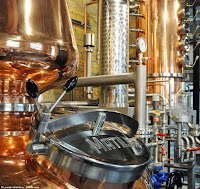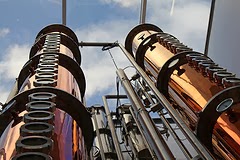A little while ago, I wrote an article on the science behind the cocktail; How some bartenders were taking drinks to a spectacular new level, even breaking them down to a molecular state of flavour. What this supposedly represents is a sea change in how we will view our beloved tipples in the future. Our drinking culture has begun to operate at two very distinct tiers: one where mass consumption and low quality homogenised goods exist to provide cheap thrills. The antithesis being bespoke, well crafted and in some cases, over engineered drinks, designed to slake the thirst of a more knowing and well educated palate. In short, it’s the ‘Con Vivant’ to the ‘Bon Vivant’.
Looking at many historical views on future culture (take Anthony Burgess’ ‘A Clockwork Orange’ for instance) and we see a grim outlook of what might occur if our drinking habits deteriorate too far into the land of Sci-Fi and are taken purely for kicks, rather than pleasure. Chemically enhanced milk is not only consumed by Alex and his gang of Droogs, but the ‘Sophistos’ dressed in dinner jackets too, suggesting that every layer of society had succumbed to such a dumbing down of standards.
But every once in a while, something comes along which reassures me that all will be well with our future drinking habits - so long as we maintain our respect for the artisan, the traditionalist and the mantra of if it ain’t broke, don’t fix it.
![]() One spirit, which exemplifies such traditions is the brandy produced in the small region of Armagnac to the South West of France. As a spirit, it is so often over shadowed by its more well-known sibling, Cognac. But any similarities are (grape) skin deep and making a comparison between the two would be like comparing Irish whiskey to Scotch. Indeed, Armagnac is actually the oldest brandy to be produced in France and although both spirits are derived from similar grape varieties (with Armagnac principally favouring a strain unique to the region called Baco) the production processes are markedly different. It is here where Armagnac comes into its own as a brandy of exceptional complexity, quality and balance.
One spirit, which exemplifies such traditions is the brandy produced in the small region of Armagnac to the South West of France. As a spirit, it is so often over shadowed by its more well-known sibling, Cognac. But any similarities are (grape) skin deep and making a comparison between the two would be like comparing Irish whiskey to Scotch. Indeed, Armagnac is actually the oldest brandy to be produced in France and although both spirits are derived from similar grape varieties (with Armagnac principally favouring a strain unique to the region called Baco) the production processes are markedly different. It is here where Armagnac comes into its own as a brandy of exceptional complexity, quality and balance.
Tracing its roots back to the 14th century, it is fabled that Armagnac had medicinal properties and a document written in 1310 (now a highly prized literary treasure in the Vatican) by Prior Vital Du Four claimed it had forty virtues, including rendering ‘men joyous, preserves youth and retards senility. And when retained in the mouth, it loosens the tongue and emboldens the wit, if someone timid from time to time himself permits.’
The Armagnac region is divided into three sub regions: Bas-Armagnac being the most highly regarded, covering over half the spirit’s production, alongside Armagnac-Tenareze, famed for its more chalky soil and Haut-Armagnac, which represents only a small amount of production in the region. Alongside the aforementioned Baco grape (which was introduced in 1898) Armagnac production relies heavily on the Ugni Blanc variety, alongside Folle Blanche and Colombard to give the briefly fermented wines distinctly different characteristics before they are distilled. Armagnac Producers favour Baco for its robust qualities and for the fact that it tends to age extremely well, with the Folle Blanche nicknamed the ‘ballet dancer of grapes’ for its temperamental traits during the growth period and the floral character it gives the finished Armagnac.
![]() |
| The Armagnac Express rolls into town... |
Traditionally the distillation of the wines happens in early November and by law must finish by no later than the end of March and it is this stage, which really characterises Armagnac as a fundamentally artisanal spirit. The stills used are radically different from the alembic pot stills used in Cognac and their design is unique to the production of Armagnac. With a Serpentine condenser (resembling a coiled snake, used to turn alcohol vapour back into a liquid) their column still design is as ingenious as it is archaic looking and until recently, Armagnac producers would tow them on the back of tractors (or in some cases by horse and cart) directly to the vineyards to distil on site. By only needing to distil once, the distiller obtains a very flavoursome and complex spirit at around 52% ABV, Cognac needing to be distilled twice to reach the same alcohol strength.
After a lengthy maturation in French oak primarily from the Monlezun forest the spirit develops its rich colour, with aromas of aged leather, dried fruit, spices and vanilla, which develop from deep within the casks. Younger Armagnacs share similarities in flavour to Cognac, but older expressions mature amazingly well, developing similar character to aged Scotch whiskies. In fact, in certain cases, particularly vintages from the late 1940s and 50’s, the Armagnac takes on a distinct rancio-like quality (a highly prized musty/savoury note, often found in very complex single malt whiskies matured in sherry casks) which pairs extremely well with robust Cuban cigars and equally so with the region’s other gastronomic delights, notably foie gras and Agen prunes.
![]() |
| Bespoke bottling at its best
|
Perhaps one of the most striking things about Armagnac is that, compared to other oak aged spirits, it remains a mystery to many drinkers, partly due to the ubiquity of its big French rival, Cognac. But when you consider that a bottle of vintage Armagnac from the late 1930’s (undoubtedly one of the finest spirits I have ever encountered) will cost you a fraction of the price of a comparable Cognac or single malt whisky, you begin to realise what a treasure trove there is to be discovered. One thing’s for sure, given the astronomical prices and increasingly high demand for the likes of premium single malt and Cognac globally, spirits enthusiasts could do far worse than occasionally considering turning their affections towards Armagnac, arguably one of the last great untapped, independent, artisanal drinking pleasures - before we’re all doomed to a diet of our favourite drinks in affordable pill form and a future controlled solely by multinational drinks companies.
Here are a number of perhaps the finest examples of Armagnacs currently worth seeking out: Again, when you consider the relative (rapidly escalating) prices of super premium single malts, you'd be a fool not to given them a cursory look...
Armagnac Delord - Hors d’ Age - 15 Year Old - 40% - around £43
Pass through the sleepy market town of Lannepax in the Bas-Armagnac region and you’ll probably miss this tiny Armagnac house in the blink of an eye. But surprisingly the company produces around 100,000 bottles a year. What’s remarkable is that the bottling process, labelling and finishing touches (wax sealing and gold embossing) are all done by hand by a team of two or three workers. Artisanal production at its best.
Nose: Elderflower notes, tangerine, sweet country fudge, a hint of milk chocolate and a touch of cinnamon, cedar and dried fruit.
Palate: The spicy/fruity note extends to the palate, with apricots, maple syrup, candied orange and a touch of tinned peach.
Finish: Vanilla, liquorice and a distinct spicy wood note.
Overall: At this price, any curious-but-not-totally-sold spirits drinkers can afford to take a punt. If you don't like it, send the rest to us and we'll swap it with you for something!
Darroze Armagnac - 40 Year Old - 43% - around £126
Darroze can rightfully be called one of the true pioneers of Armagnac, partly as the company has helped to make the spirit much more accessible outside of France. Under the tenure of the current custodian, Marc Darroze, a huge selection of vintages has been assembled, each one coming from grapes produced by specific farmers, alongside bottlings ranging from 10-60 years old.
Nose: Orange and lemon zest, cigar box notes, fresh cherries, almonds, marzipan and a wonderful sweet strawberry note.
Palate: Powerful and complex, with a strong rancio note, alongside dried fruit, liquorice spiciness and toasted orange peel.
Finish: Dark caramel notes and a dry oakiness give this some extreme length.
Overall: 40 year old liquid for under £130. Think about that for a second, then ignore the price, open it and invite your regular spirits pals around. They'll thank you for this introduction...
Armagnac Castarède - 1939 Vintage - 40% - around £750
Castarède is one of the oldest Chateaus still producing Armagnac and the company is still proudly family-owned, today by the formidable Florence Castarède. Alongside some sensational younger spirits, notably the 10 year old VSOP and 20 year old Hors ‘d Age (‘Beyond Age’) Castarède pride themselves on producing some exceptionally old vintage bottlings.
Nose: Blackberry leaf, effortless dried fruits, hints of butterscotch, some light charred notes and cherries in muscovado sugar.
Palate: An intoxicating explosion of passion fruit, blackberry, a little spicy liquorice and an oaky, tannic coffee backing. Absolutely peerless.
Finish: Lingering notes of rich vanilla, dried fruit and woody spice.
Overall: An astonishing spirit, full of wisdom, complexity and personality, with stories to tell as long as you have time to sit there and enjoy them. I was lucky enough to have a small measure of this and it will rank as one of the most enjoyable and enlightening drinking experiences I think i've ever encountered.
 Bowmore's lighter, more floral style is slowly but surely capturing the attention of many (nearly) peat ready palates, as well as slaking the thirst of those who are suffering from P.F.S - or Peat Fatigue Syndrome - believe me - it will hit all whisky drinkers (no matter how much they claim to love the smoky stuff) at some point in their drinking career.
Bowmore's lighter, more floral style is slowly but surely capturing the attention of many (nearly) peat ready palates, as well as slaking the thirst of those who are suffering from P.F.S - or Peat Fatigue Syndrome - believe me - it will hit all whisky drinkers (no matter how much they claim to love the smoky stuff) at some point in their drinking career. 




















.jpg)



.jpg)






































